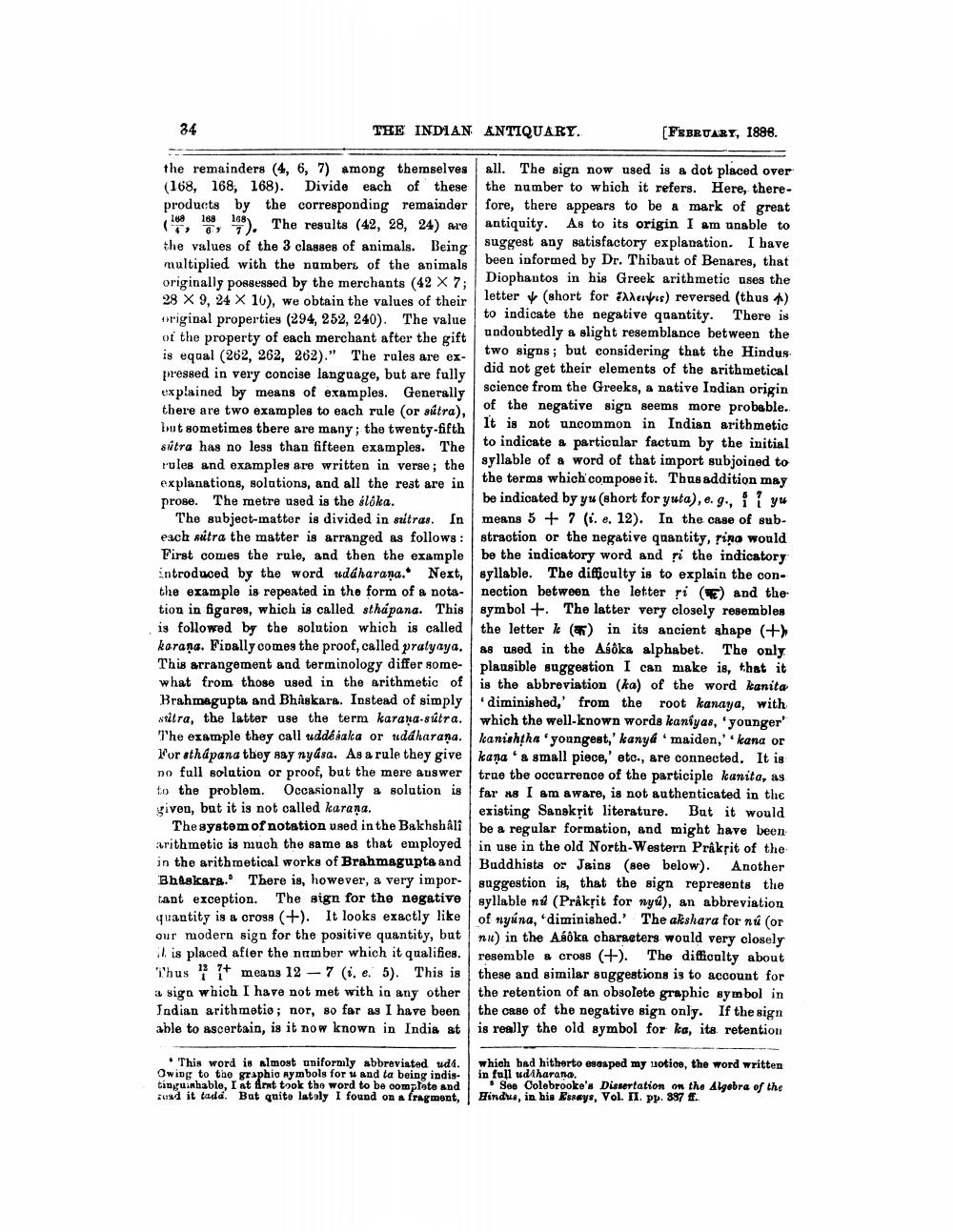________________
34
THE INDIAN ANTIQUARY.
[FEBRUARY, 1888.
the remainders (4, 6, 7) among themselves all. The sign now used is a dot placed over (168, 168, 168). Divide each of these the number to which it refers. Here, thereproducts by the corresponding remainder fore, there appears to be a mark of great (188, 188, 18). The results (42, 28, 24) are | antiquity. As to its origin I am unable to the values of the 3 classes of animals. Being suggest any satisfactory explanation. I have multiplied with the numbers of the animals
been informed by Dr. Thibaut of Benares, that originally possessed by the merchants (42 X 7;
Diophantos in his Greek arithmetic uses the 28 X 9, 24 X 10), we obtain the values of their
letter (short for denyus) reversed (thus ) original properties (294, 252, 240). The value
to indicate the negative quantity. There is of the property of each merchant after the gift
undoubtedly a slight resemblance between the is equal (262, 262, 262)." The rules are ex
two signs; but considering that the Hindus pressed in very concise language, but are fully
did not get their elements of the arithmetical explained by means of examples. Generally
science from the Greeks, a native Indian origin there are two examples to each rule (or satra),
of the negative sign seems more probable. but sometimes there are many; the twenty-fifth
It is not uncommon in Indian arithmetic sútra has no less than fifteen examples. The
to indicate a particular factum by the initial rules and examples are written in verse; the
syllable of a word of that import subjoined to explanations, solutions, and all the rest are in
the terms which compose it. Thus addition may proge. The metre used is the slóka.
be indicated by yu (short for yuta), e.g., i l yu The subject matter is divided in sitras. n means 5 + 7 (i. e. 12). In the case of subeach sutra the matter is arranged as follows: straction or the negative quantity, rino would First comes the rule, and then the example be the indicatory word and ri the indicatory introduced by the word udáharana.. Next, syllable. The difficulty is to explain the conthe example is repeated in the form of a nota-nection between the letter ri () and the tion in figures, which is called sthápana. This symbol + The latter very closely resembles is followed by the solution which is called the letter l (*) in its ancient shape (+) karana. Finally comes the proof, called pratyaya. as used in the Asoka alphabet. The only This arrangement and terminology differ some plausible suggestion I can make is, that it what from those used in the arithmetic of is the abbreviation (ka) of the word kanita Brahmagupta and Bhaskara. Instead of simply diminished, from the root kanaya, with sitra, the latter use the term karana-sútra. which the well-known words kaniyas, 'younger The example they call uddésala or uddharana. Icanishtha 'youngest,' kanya 'maiden,'kana or For sthapana they say nyása. As a rule they give kana' & small piece,' etc., are connected. It is po full solution or proof, but the mere answer true the occurrence of the participle kanita. as to the problem. Occasionally a solution is far as I am aware, is not authenticated in the given, but it is not called karana.
existing Sanskpit literature. But it would The system of notation used in the Bakhshali be a regular formation, and might have been arithmetic is much the same as that employed in use in the old North-Western Pråkpit of the in the arithmetical works of Brahmagupta and Buddhists or Jains (see below). Another Bhaskara. There is, however, a very impor- suggestion is, that the sign represents the tant exception. The sign for the negative syllable nu (Prakrit for nyú), an abbreviation quantity is a cross (+). It looks exactly like of nyúna, diminished. The akshara for nú (or our modern sign for the positive quantity, but nu) in the A.boka characters would very closely l is placed after the number which it qualifies. resemble a cross (+). The difficulty about ihus 1 7+ means 12 - 7 (. e. 5). This is these and similar suggestions is to account for a sign which I have not met with in any other the retention of an obsolete graphic symbol in Indian arithmetio; nor, so far as I have been the case of the negative sign only. If the sign able to ascertain, is it now known in India at is really the old symbol for ka, its retention
. This word is almost uniformly abbreviated ud. Owing to the graphio symbols for 1 and ta being indis. tinguinhable. I at Art took tho word to be complete and zosd it tadá. But quite latoly I found on a fragment,
which had hitherto escaped my notice, the word written in full udlharana.
See Colebrooke's Dissertation on the Algebra of the Hindus, in his Essays, Vol. II. pp. 397 ff.




